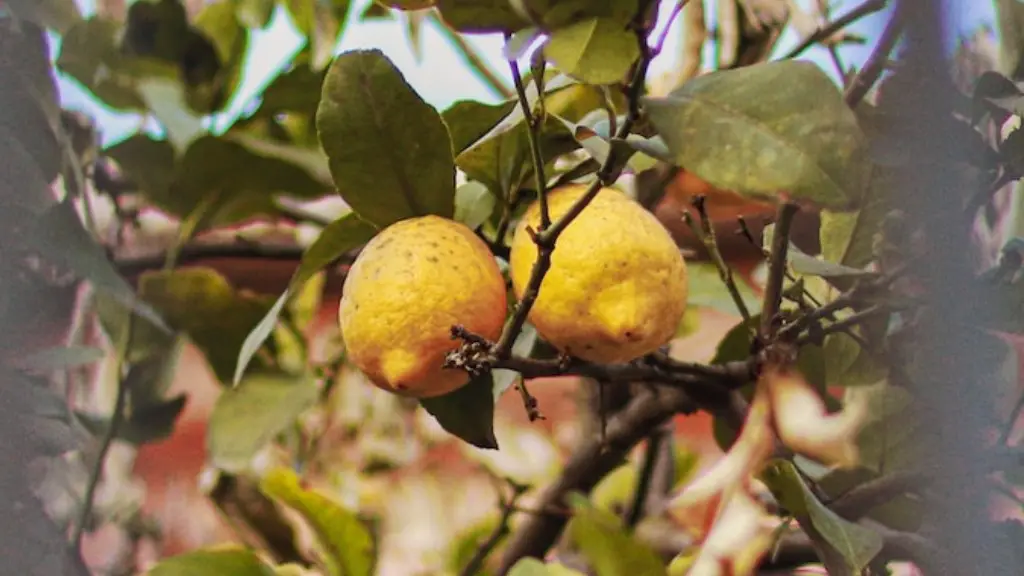Growing a lemon tree from a seed is an enjoyable, cost effective way to add a vibrant, citrusy splash to your home. Here is a step-by-step guide to get started:
Firstly, purchase or collect a healthy lemon. Place the lemon in a bowl and extract the lemon seeds. Rinse the seeds in cold water to remove the sticky fruit.
Next, fill a small pot with soil, moisten the soil and create a small depression at the top of the soil. Place the lemon seeds into the depression and cover lightly with soil.
Thirdly, moisten the soil regularly to keep it moist. Place the pots in a sunny location away from direct sunlight and allow the seedling to grow.
Fourthly, wait for the seedling to reach about 3-4 inches in height and transfer to a larger pot with a new mix of soil. Additionally, use small, steady amounts of fertilizer to provide nutrients to the seedling.
Fifthly, prune the lemon tree to keep it small and bushy. New growth will need to be pruned to encourage more growth and branches.
Lastly, water the lemon tree regularly. Pay attention to the soil and water accordingly; waterlogged soil will prevent the roots from growing and can cause harm to the tree.
Pests, Diseases and Other Considerations
Most lemon trees are particularly vulnerable to freezing temperatures and should be brought indoors or covered during cold months. Further, lemon trees are susceptible to pests and diseases and require regular care and attention.
Common pests such as white fly, mealybugs and mites should be addressed quickly and swiftly. Insecticidal soaps, oils and systemic sprays will help to keep them away and prevent damage to the tree. Additionally, diseases such as botrytis, canker and blotch need to be immediately identified and treated.
If you’re living in a cold area, you may wish to grow the lemon tree in a container so that you can move it indoors if needed. Additionally, the lemon tree will thrive when the temperatures remain above 60F (15C).
Finally, during fruit season, make sure to plant your tree in a sunny spot with at least 6 hours of direct sunlight a day. Prune the tree to keep it healthy and allow wind to circulate.
Harvesting and Storing Lemons
Lemon trees begin to produce fruit after 2-3 years. Counterintuitively, they should not be picked when they’re bright yellow in color. Instead, wait until they’re yellow and a bit soft when touched. Otherwise, harvested lemons may be sour or lack sweetness.
One of the best ways to a store a large haul of lemons is to turn them into lemonade or lemon syrup. To make lemon syrup, add 6 cups of sugar and 2 cups of bottled lemon juice to a saucepan, stir and bring to a boil. Reduce the heat and simmer until the mixture is syrupy. Allow the mixture to cool and store in an airtight container.
Another great way to store lemons is to make lemon peel liqueur. To make the liqueur, take a large bowl and place the lemon peels inside. Add ½ cup of vodka for every cup of peel, cover with a lid and place in a cool place for about 2 weeks. Strain the liqueur, add simple syrup to sweeten it and store in airtight bottles.
The peel liqueur can be consumed as is or used in cakes and other culinary treats. Alternatively, you can freeze the lemons without their peel, put them in airtight bags, and they’ll last up to several months.
Citrus Hybrids and Varieties
Lemon trees come in many shapes, sizes and varieties. Depending on the variety, some lemons will be sweet or sour and others will produce more juice or yield more stems or branches. Hybrids provide an extensive range of options to choose from.
One popular hybrid is the Meyer lemon,a lemon which combines the features of a true lemon and an orange. It has more orange than yellow skin, with smooth, pebble-like texture, a deliciously fragrant and tart flavor and thick skin. Other hybrids to consider are of the Dorshapore, with its yellow and green mottled skin, and Labe bus, a tart and fragrant lemon that’s incredibly easy to peel.
These are just a handful of the many varieties of lemons trees and hybrids to discover, explore and experiment with. After all, what better way to enjoy a bountiful harvest Every year, using little to no cost other than hard work and a bit of patience!
Proper Analyses of Growing Lemon Trees
Before growing a lemon tree, it is important to analyze the ecological and environmental conditions to ensure the optimal growth of the tree. Factors such as soil, light, temperature and water are all essential to the vitality of the tree, and it is best to ensure they are all in accordance with the ideal conditions.
Soil requirements are key when growing a lemon tree. The soil should be clay-loam or alluvial, with a pH ranging from 5.5 to 8.5. Too basic or too acidic a soil will damage the tree. Additionally, it should have an excellent drainage system and be well aerated, as lack of oxygen can prevent nutrients from reaching the roots.
Lemon trees require plenty of sunlight. When choosing a spot, ensure it is exposed to at least 6 hours of direct sunlight a day. Providing protective shade during the hottest hours of the day can help prevent damage to the tree.
Temperature restriction is also a factor. Lemon trees perform best when temperatures are between 50-85F (10-30C)–any lower or higher can affect the flavors and delay production of fruit. Additionally, nearby air is also important; good air flow prevents molds from dwelling near the tree.
Finally, water requirements are an important part of lemon harvesting. Good drainage is key, as large amounts of water can damage the tree’s roots. However, during dry spells, the lemon tree should be watered regularly for the best results. Furthermore, it is best to avoid sprinkling the tree’s leaves and fruit, as moisture is good but too much can spread fungal diseases.
Propagating Lemon Trees
Propagating a lemon tree is also an option, and it is a great way to ensure a continued supply of lemon trees. It is best to propagate lemon trees using a rootstock, as it will grow faster and larger than the seed-grown tree. Additionally, a rootstock makes the tree more resistant to diseases and enables its optimal growth.
To propagate a lemon tree, first select the desired rootstock. Then, remove the soil from the unwanted parts of the rootstock and place it in a warm and sunny spot. Make sure to keep the soil moist and wait for the top part of the rootstock to sprout and new leaves to start growing.
Once the desired parts of the rootstock have sprouted and are at least 3 to 6 inches in height, begin to transfer it to a pot or permanent place in the garden. Make sure to place it in the same conditions in which it was previously growing.
Provide optimal sunlight, water and soil for the trees to grow healthily and protect them from cold temperatures. Propagation also requires pruning to encourage strong growth, so set aside time every few months to prune the branches and stems of your lemon tree.
Fertilizer Application
One of the most important ingredients in growing a healthy lemon tree is fertilizer. It helps provide vital nutrients for the plant and promote development of new leaf and flower buds. Fertilizers are high in nitrogen, phosphorus, and potassium, and can provide the tree with much-needed minerals.
It is important to read the labels on the fertilizer before applying it in order to ensure the correct application rate is used. Depending on the type of fertilizer being used, the amounts vary and too much or too little application can cause damage to the tree.
Fertilizers should be applied every month during the growing season, or spring and summer. Take care to read instructions on packaging carefully to avoid damaging the tree. Fertilizers should be incorporated into the soil around the roots, but never should it be added directly to the trunk or the leaves of the tree.
It is also important to conduct regular soil tests. Testing the soil can be done from a nearby nursery, or in some cases at home. Soil tests help determine the soil’s pH level, nitrogen, and other nutrients, and also what type of fertilizer is best for the tree.
In conclusion, growing a lemon tree from a seed is not an overly difficult task, and following these steps will help ensure a healthy, juicy tree: use healthy seeds, replant in a different pot when seedling becomes about 4-5 inches tall, provide consistent sunlight, water regularly and make sure to fertilize.



